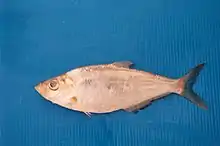Ilisha elongata
The elongate ilisha (the FAO name) (Ilisha elongata), also known as the Chinese herring or slender shad (although not a true herrings ) (Chinese: 勒鱼; pinyin: lèyú or simply 鳓, lè), is a species of longfin herring native to the coastal waters and estuaries of North Indian Ocean and Northwest Pacific. It is a relatively large species, up to 45–60 centimetres (18–24 in) in total length. It is an important fishery species.[2][3]
| Elongate ilisha | |
|---|---|
 | |
| Elongate ilisha on sale in a Chinese supermarket | |
| Scientific classification | |
| Kingdom: | |
| Phylum: | |
| Class: | |
| Order: | |
| Family: | |
| Genus: | |
| Species: | I. elongata |
| Binomial name | |
| Ilisha elongata Bennett, 1830 | |
| Synonyms[1] | |
|
Pellona elongata Bennett, 1830 | |

Life history
In the northern part of its range, Ilisha elongata matures at age of 2 years and has a lifespan of about 6 years; in the warmer parts of its range, it matures under age 1 year and has a lifespan of about 3 years. It can spawn several batches of eggs.[4]
Fisheries and use
The species is commercially fished. Based on the FAO fishery statistics, the annual catches ranged between 80,400 and 98,700 tonnes in 2000–2009, all of them from the Northwest Pacific (FAO Fishing Area 61) and almost all of them caught by China.[5] The meat is tasty but has many bones.
References
- "Ilisha elongata". Integrated Taxonomic Information System. Retrieved 27 May 2012.
- Froese, Rainer and Pauly, Daniel, eds. (2011). "Ilisha elongata" in FishBase. November 2011 version.
- Whitehead, Peter J.P. (1985). FAO species catalogue. Vol. 7. Clupeoid fishes of the world. An annotated and illustrated catalogue of the herrings, sardines, pilchards, sprats, anchovies and wolfherrings. Part 1 - Chirocentridae, Clupeidae and Pristigasteridae (PDF). Rome: FAO. pp. 265–266. ISBN 978-92-5-102340-2.
- Zhang, J.; Takita, T.; Zhang, C. (2009). "Reproductive biology of Ilisha elongata (Teleostei: Pristigasteridae) in Ariake Sound, Japan: Implications for estuarine fish conservation in Asia". Estuarine, Coastal and Shelf Science. 81 (1): 105–113. Bibcode:2009ECSS...81..105Z. doi:10.1016/j.ecss.2008.10.013.
- FAO (Food and Agriculture Organization of the United Nations) (2011). Yearbook of fishery and aquaculture statistics 2009. Capture production (PDF). Rome: FAO. pp. 91–92.